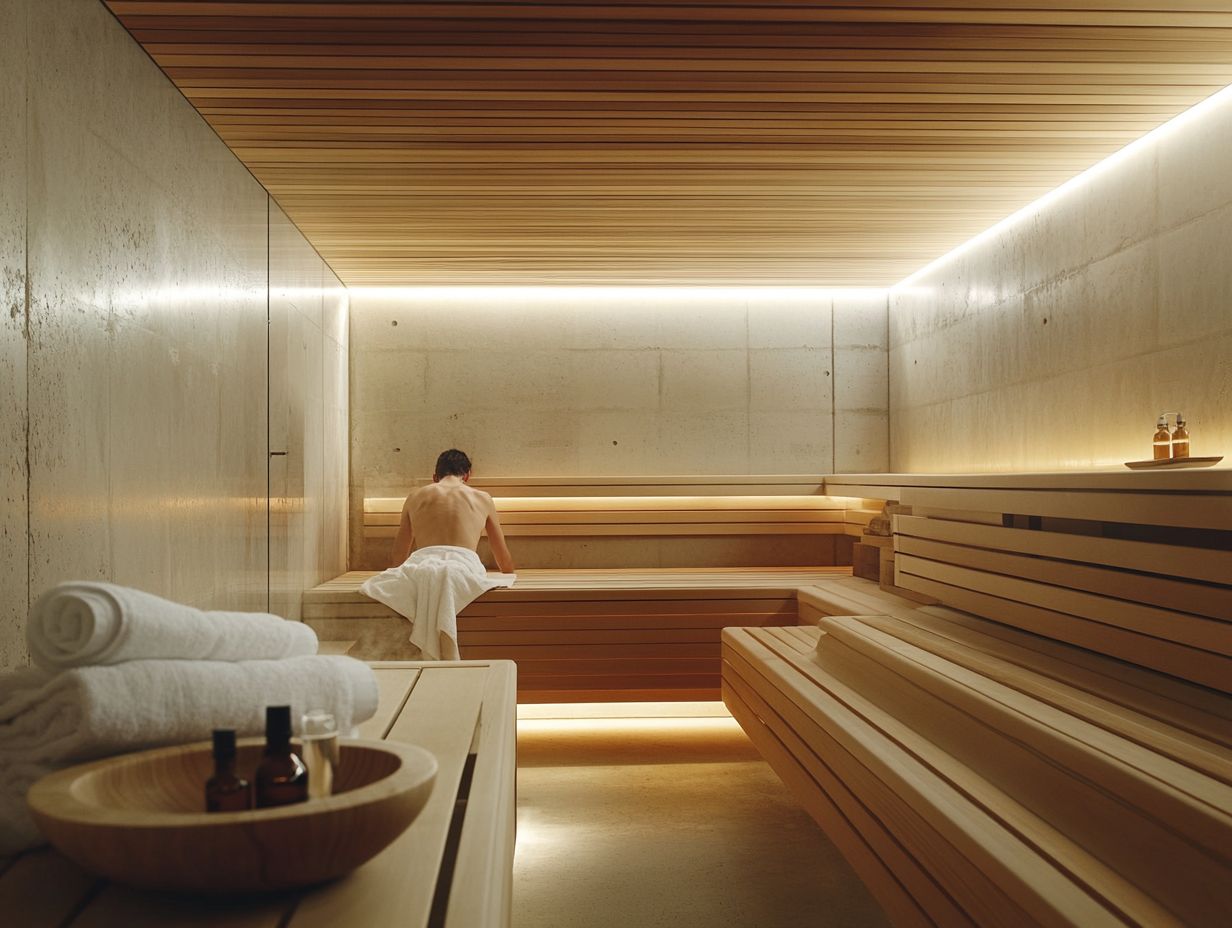5 Creative Ways to Enjoy Saunas Safely
Saunas provide a remarkable fusion of relaxation and health benefits, but embracing them safely is crucial to fully harness their positive effects.
Here are five strategies to elevate your sauna experience while prioritizing your well-being:
- Stay hydrated.
- Know your limits.
- Familiarize yourself with different types of saunas, like traditional and infrared, and their precautions.
By following these strategies, you can ensure that each sauna session is enjoyed to the fullest.
You will also learn about common myths surrounding saunas, along with alternative methods to benefit from heat therapy, like meditation and breathing exercises. Prepare to enhance your self-care routine!
Contents
Key Takeaways:

- Use a timer and stay hydrated to prevent heat exhaustion and dehydration, especially during sauna sessions.
- Avoid alcohol and other substances to ensure a safe and clear-minded sauna experience.
- Take breaks and cool down periods to regulate body temperature and avoid overexposure to heat.
1. Use a Timer and Stay Hydrated
Using a timer during your sauna sessions is essential for maximizing health benefits while ensuring you stay adequately hydrated. High temperatures and humidity in the sauna can lead to significant sweating and loss of minerals if not managed properly.
Before you step into the sauna, make sure to drink enough water to prepare your body for the heat. During your session, consider sipping on electrolyte-rich beverages like coconut water or sports drinks to replenish lost minerals such as sodium and potassium.
After your sauna experience, indulge in hydrating foods like fruits and vegetables to further aid in recovery. By implementing these hydration strategies, you ensure your body remains in optimal condition, allowing for a more enjoyable sauna session.
Keep in mind that maintaining proper hydration not only enhances your physical health but also boosts mental clarity and relaxation.
2. Avoid Alcohol and Other Substances
To fully savor the relaxation and health benefits that saunas offer, steer clear of alcohol and other substances that could compromise your safety and well-being. The combination of high temperatures and intoxicating agents can lead to perilous situations.
Alcohol can significantly contribute to dehydration, intensifying the effects of sauna heat on your body. When paired with elevated temperatures, alcohol increases the risk of overheating and clouds your judgment, making it harder to recognize your physical limits.
Instead of indulging in alcohol, consider alternative relaxation techniques such as meditation or gentle stretching to elevate your sauna experience. By prioritizing a clear mind, you ensure a safer and more enjoyable session while deepening your appreciation for the therapeutic benefits that saunas can provide.
3. Take Breaks and Cool Down Periods
Don’t forget to take breaks! They are key to maximizing your sauna experience and enhancing relaxation while prioritizing your safety and overall health. Alternating between sweating and cooling helps optimize detoxification and allows your body to adjust effectively to temperature changes.
After each session, it s crucial to allow your body to recover. This practice aids in muscle relaxation and helps prevent overheating. Consider taking a cool shower or indulging in a cold plunge; these methods invigorate your skin and stimulate circulation.
Staying hydrated is non-negotiable drinking water or herbal teas post-session replenishes lost fluids, ensuring you remain properly hydrated. This thoughtful combination of cool-down techniques enhances your sauna experience and amplifies its health benefits, including improved cardiovascular function and a boosted immune response.
Now that you know how to enjoy saunas safely, why not schedule your next sauna session and put this knowledge into practice?
4. Wear Proper Attire and Towels

Wearing the right clothes and using towels in the sauna not only increases your comfort but also respects the shared experience of this time-honored practice. This consideration enhances your sauna visit, promoting relaxation and well-being during your heat treatment sessions.
Choosing suitable sauna attire whether a swimsuit or, ideally, nothing at all allows for proper airflow. This helps maintain the high temperatures essential for effective detoxification, which is the process of removing toxins from the body, and relaxation. In a communal sauna, using a towel goes beyond hygiene; it shows consideration for others by providing a clean barrier between your body and the surfaces.
Towels also enhance your relaxation, making it easier to find that sweet spot of comfort while protecting your skin from excessive heat. Thoughtfully selecting your towel and attire can truly transform an ordinary sauna visit into a profoundly enjoyable and rejuvenating experience, especially with sauna accessories like essential oils for added aromatherapy.
5. Know Your Limits and Listen to Your Body
Know your limits and listen to your body when using a sauna. This mindfulness helps prevent potential health risks and ensures a safe and enjoyable experience, maximizing the well-being benefits of this ancient Finnish practice.
Being present during your sauna sessions allows you to recognize signs of overheating or distress dizziness, excessive sweating, or nausea. Don t ignore your body’s signals! To effectively gauge your limits, start with shorter sessions and gradually increase the duration as you become more comfortable.
Staying hydrated before, during, and after your sauna time is vital for supporting your overall health and enhancing the benefits of heat treatment. Light breathing exercises can help you understand your comfort levels. Tuning into your physical sensations leads to a more fulfilling sauna experience, enhancing your relaxation and detoxification.
What Are the Benefits of Saunas?
Saunas offer numerous health benefits, from detoxification and improved circulation to heightened relaxation and stress relief. Regular sauna use isn t just about relaxation; it also supports better cardiovascular health, weight management, and enhanced mental well-being especially when paired with practices like breathing exercises and meditation.
Research shows that routine exposure to traditional and infrared saunas can significantly lower blood pressure, improve endothelial function, and reduce the risk of heart disease. With the delightful heat enveloping you, your heart rate may increase, mimicking the effects of exercise and boosting your cardiovascular fitness.
In terms of weight loss, elevated temperatures in saunas can trigger sweating, resulting in a temporary weight drop while also enhancing your metabolic rate. On the mental health front, studies indicate that sauna bathing can lower cortisol levels, fostering relaxation and easing symptoms of anxiety and depression.
To truly harness these benefits, remember to stay hydrated, gradually acclimatize to the heat, and incorporate calming breathing techniques during your sauna sessions.
How Can Saunas Be Dangerous?
While saunas provide a wealth of health benefits, they can also pose certain risks if safety precautions aren t observed. Issues such as dehydration, overheating, and the aggravation of specific health conditions can arise. Understanding your body s limits and the environment in which you’re relaxing is essential.
Dehydration can creep up on you if you’re not vigilant about your fluid intake before and after your sauna session. It’s also crucial to be aware of any pre-existing health concerns, such as cardiovascular issues or respiratory conditions, which may be exacerbated by the intense heat.
If you re uncertain about how saunas might impact your health, it s wise to consult medical professionals. Regular check-ins with your healthcare provider can help tailor your sauna experience, ensuring that the potential risks don t overshadow the remarkable benefits.
Start your sauna journey today for a healthier you!
What Are the Different Types of Saunas and Their Safety Precautions?

Understanding the different types of saunas, like traditional and infrared, is vital for maximizing health benefits and ensuring your safety. Each type offers unique features and comes with specific precautions, such as the need for proper hydration and awareness of humidity levels.
Traditional saunas typically operate at higher temperatures, ranging from 150 to 195 degrees Fahrenheit, with high humidity, which can make the environment feel even hotter. This type often fosters a spirited, social atmosphere, reminiscent of time-honored customs.
In contrast, infrared saunas operate at lower temperatures, usually between 120 and 140 degrees Fahrenheit. They allow for deeper tissue penetration without the intense heat, resulting in a more tranquil, personal experience.
Safety is paramount with both types. Limit your sessions to around 15-20 minutes in traditional saunas and up to 30-45 minutes in infrared ones. Stay hydrated to ensure your sauna experience is safe and enjoyable!
How Can One Incorporate Saunas into Their Self-Care Routine?
Incorporating saunas into your self-care routine can elevate relaxation, sharpen mental clarity, and boost your physical well-being. This transforms your routine into a powerful ally for overall health, especially when paired with practices like yoga or meditation.
Consider the timing of your sessions to maximize benefits. Aim for a sauna visit after workouts or on particularly stressful days to enhance muscle recovery and melt away tension. You can also integrate deep breathing exercises or gentle stretching while you unwind.
Create a tranquil environment for the best experience. Dim the lights, play soothing music, or use aromatherapy with essential oils to cultivate a calming atmosphere. By incorporating sauna use into a broader regimen that prioritizes both physical and mental wellness, you nurture a more balanced lifestyle.
What Are the Common Myths About Sauna Safety?
Debunking common myths about sauna safety is essential for fostering safe practices and maximizing health benefits. Misconceptions surrounding hydration, duration, and suitability can lead to negative encounters that detract from your relaxation.
You may have heard that spending longer in a sauna guarantees greater benefits. The truth is that too much time can lead to dehydration and heat-related issues. Many believe saunas aren t for everyone, which overlooks the fact that many can enjoy them with the right guidelines. Stay well-hydrated before, during, and after your sauna sessions, and listen to your body regarding duration typically, 15 to 20 minutes per session is recommended.
By clarifying these points, you can enjoy a safe and enriching sauna experience while fully embracing the overall advantages of regular use.
What Are the Alternative Ways to Enjoy the Benefits of Saunas?
Exploring alternative ways to enjoy sauna benefits can broaden your wellness horizon. You can achieve similar health effects and relaxation opportunities through methods like steam rooms, hot baths, and cold treatment therapies.
These options offer unique features and advantages that can enhance your overall experience. For instance, steam rooms promote deep relaxation and hydration, making them ideal for those seeking relief from respiratory issues. Hot baths combine soothing water temperatures with mineral-rich salts, aiding in muscle recovery and stress reduction.
Cold therapy such as ice baths or contrast showers not only invigorates your body but also helps reduce inflammation and improve circulation.
By incorporating these alternatives into your wellness routine, you may uncover new dimensions of relaxation and health benefits that beautifully complement your traditional sauna experience.
Frequently Asked Questions

What are 5 creative ways to enjoy saunas safely?
- Stay hydrated: Be sure to drink plenty of water before, during, and after your sauna session to prevent dehydration.
- Use a towel: Place a towel on the bench to avoid direct contact with the hot surface and to absorb sweat.
- Take breaks: Don t stay in the sauna for too long. Take breaks to cool down and regulate your body temperature.
- Avoid alcohol and drugs: Drinking alcohol or using drugs before or during a sauna can be dangerous and increase the risk of dehydration and overheating.
- Use a timer: Set a timer for your sauna session to ensure you don’t stay in too long and can take breaks as needed.
How can I make my sauna experience more enjoyable and safe?
- Use essential oils: Add a few drops of your favorite essential oils, natural extracts from plants that enhance your experience, to the water on the hot rocks for a relaxing aroma.
- Listen to music: Bring a portable speaker and enjoy calming music or nature sounds to enhance your relaxation.
- Bring a friend: Having a sauna session with a friend makes it more enjoyable and adds an extra level of safety and support.
- Use a sauna hat: Wearing a sauna hat protects your head and hair from heat while preventing dehydration.
- Use a thermometer: Keep a thermometer in the sauna to monitor the temperature and ensure it doesn t get too hot.
Can I use a sauna safely if I have a medical condition?
It s best to consult your doctor before using a sauna if you have a medical condition. Some conditions, such as high blood pressure or heart disease, may worsen with heat and humidity. On the other hand, respiratory conditions may benefit from steam and heat. Your doctor can advise you on whether it’s safe for you to use a sauna.
Are there any precautions I should take when using a sauna?
Yes, keep a few precautions in mind:
- Stay hydrated.
- Take breaks.
- Avoid alcohol and drugs.
It s also important to listen to your body. If you feel dizzy, lightheaded, or unwell, leave the sauna immediately.
Is it safe to use a sauna during pregnancy?
It s best to avoid using a sauna during pregnancy. High temperatures and humidity can be dangerous for both the mother and the baby. The heat can also lead to dehydration and may increase the risk of birth defects. Consult your doctor before using a sauna while pregnant.
How often should I use a sauna?
The frequency of sauna use depends on the individual and their health. Generally, it s recommended to limit sauna sessions to a maximum of three times per week. Listen to your body and take breaks as needed. If you have underlying health conditions, consult your doctor before sauna use.





